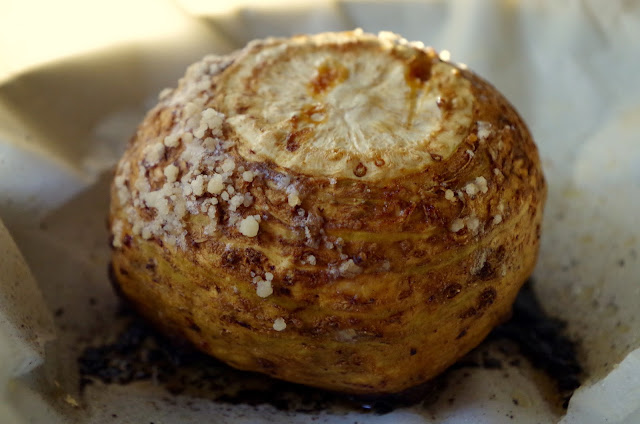Soufflé aux Épinards



Here's some good stuff about the soufflé from On Food and Cooking: The Science and Lore of The Kitchen by Harold McGee:
"Soufflés--savory and sweet mixes lightened with an egg-white foam, then dramatically inflated above their dish by oven heat--have the reputation for being difficult preparations...In fact, soufflés are reliable and resilient...If you manage to get any air into the mix, an inexorable law of nature will raise it in the oven, and opening the door for a few seconds won't do it any harm. The inevitable post-oven deflation can be minimized by your choice of ingredients and cooking method...
The physical law that animates the soufflé was discovered a few decades after its invention by--appropriately--a French scientist and balloonist, J.A.C. Charles. Charles's law is this: all else equal, the volume occupied by a given weight of gas is proportional to its temperature. Heat an inflated balloon and the air will take up more space, so the balloon expands. Similarly, put a soufflé in the oven and its air bubbles heat up and swell, so the mix expands in the only direction it can: out the top of the dish.
Charles's law is part of the story, but not the whole story--it accounts for about a quarter of the typical soufflé rise. The rest comes from the continuous evaporation of water from the bubble walls into the bubbles. As portions of the soufflé approach the boiling point, more liquid water becomes water vapor and adds to the quantity of gas molecules in the bubbles, which increases the pressure on the bubble walls, which causes the walls to stretch and the bubbles to expand...
Charles's law also means that what must go up in the oven must come down at the table...As the soufflé bubbles cool, the air they contain contracts in volume, and the vapor that come from liquid water in the mix condenses back into liquid...A thick souffle mix can't rise as easily, but it also won't fall as easily...Don't worry about opening the oven door. The mix can't fall unless it actually begins to cool down, and even if that did happen, it will rise again when it heats up again."
So there you have it. I went the Swiss cheese and spinach route, and I was well rewarded with a very tasty, very light soufflé. We liked this so much we contemplated just whom we could invite over for a brunch that included soufflés. Perhaps you are available?
-------------
Soufflé aux Épinards
Adapted from Mastering the Art of French Cooking
Yield:
Serves 4
Ingredients:
1 teaspoon butter
1 tablespoon Swiss or Parmesan cheese
1 tablespoon minced shallots or green onion
1 tablespoon butter
3/4 cup blanched chopped spinach
1/4 teaspoon salt
3 tablespoons butter
3 tablespoons flour
1 cup boiling milk
1/2 teaspoon salt
1/8 teaspoon pepper
Pinch of cayenne pepper
Pinch of nutmeg
4 egg yolks
5 egg whites
Pinch of salt
1/3 to 1/2 cup of grated Swiss cheese
Instructions:
1. Measure out all your ingredients. Butter inside of a soufflé mold and sprinkle with cheese. Preheat oven to 400 degrees.
2. Cook the shallots or onions for a moment in the butter. Add spinach and salt, and stir over moderately high heat for several minutes to evaporate as much moisture as possible from the spinach. Remove from the heat.
3. Melt the butter in a 2-1/2 quart saucepan. Stir in the flour with a wooden spatula or spoon and cook over moderate heat until butter and flour foam together for two minutes without browning. Remove from heat; when the mixture has stopped bubbling, pour in all the boiling milk at once. Beat vigorously with a wire whip until blended. Beat in the seasonings. Return over moderately high heat and boil, stirring with the wire whip, for 1 minute. The sauce will be very thick.
4. Remove from heat. Immediately start to separate the eggs. Drop the white into the egg white bowl and the yolk into the center of the hot sauce. Beat the yolk into the sauce with the wire whip. Continue in the same manner with the rest of the eggs. After the egg yolks have been beaten in, stir in the spinach. Correct seasoning.
5. Beat the egg whites and salt until stiff. Stir one fourth of them into the sauce. Stir in all but a tablespoon of the cheese. Fold in the rest of the egg whites and turn mixture into prepared mold. Sprinkle with remaining cheese and set on a rack in the middle of preheated oven. Turn heat down to 475 degrees and bake for 25 to 30 minutes. The soufflé will have puffed 2 inches over the rim of the mold, and the top will be nicely browned. Bake 4-5 minutes more to firm it up, then serve at once.












I love the science here! Makes perfect sense.
ReplyDeleteI am so glad it passes the science test! Hooray.
ReplyDelete